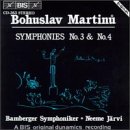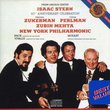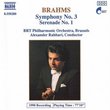| All Artists: Bohuslav Martinu, Neeme Järvi, Bamber Symphony Title: Bohuslav Martinu: Symphonies No. 3 & No. 4 - Bamberg Symphony / Neeme Järvi Members Wishing: 0 Total Copies: 0 Label: Bis Release Date: 3/25/1994 Album Type: Import Genre: Classical Styles: Historical Periods, Modern, 20th, & 21st Century, Symphonies Number of Discs: 1 SwapaCD Credits: 1 UPCs: 750582018428, 7318590003633 |
Search - Bohuslav Martinu, Neeme Järvi, Bamber Symphony :: Bohuslav Martinu: Symphonies No. 3 & No. 4 - Bamberg Symphony / Neeme Järvi
 | Bohuslav Martinu, Neeme Järvi, Bamber Symphony Bohuslav Martinu: Symphonies No. 3 & No. 4 - Bamberg Symphony / Neeme Järvi Genre: Classical
|
Larger Image |
CD DetailsSimilar CDs
Similarly Requested CDs
|
CD ReviewsHear this music or you've heard nothing yet MartinP | Nijmegen, The Netherlands | 04/22/2002 (4 out of 5 stars) "Martinu's war-time 3rd symphony is, in my view, one of the most astonishing pieces of music to be written in the 20th century, and holds (again in my view) a fair claim to being one of the, say, 25 greatest symphonies of all time. It certainly surpasses in consistentency and concentration anything Shostakovich ever wrote - or Tchaikovsky for that matter. Martinu's style is unmistakable: the restlessly shifting rhythms, the snatches of melancholy folk-song tunes, the dark timbre of low piano notes underneath it all. There are rhythmic complexities here that boggle the mind, and yet sound completely natural (listen to that astonishing sequence of superimposed triplets, semiquavers, and demi-semiquavers pushing forward and upward relentlessly and mysteriously in the slow movement). The first two movements are distinctly dark-hued, with a harrowing sense of foreboding. The finale then fights these dark forces with considerable energy, and almost comes out victorious. There are some fascinatingly ambiguous passages here - most notably of course the one near the end where a solo string quartet sings an infinitely tender, slow, diatonic melody while the woodwinds stumble along underneath with sequences of chromatic semiquavers. It is an unparallelled vision of the dream of perfection (in this case probably peace, and the longed-for homeland) and the concurrent imperfections of the real world (including exile in Connecticut, where the work was written) that will forever prevent its realisation. So that even though the music turns euphoric for a bit after this, it couldn't end otherwise than with the motto taken from Dvorak's Requiem (already recycled in a similar vein by Suk in his Asrael symphony), and those grumpy, dissonant piano chords that leave the listener in an unsettling emotional limbo. Järvi's recording serves the piece well, though I am less enthusiastic than some about the sound quality itself. It is really rather fuzzy: a lot of the grittier detail going on in secondary voices is inaudible much of the time; and the harp could just as well have stayed at home altogether. Louder passages are however truly impressive (the start of the Finale is definitely life-threatening to those with heart complaints), and the Bamberg players can hardly be faulted. Järvi too steers a pretty clearheaded course, though one or two times he indulges in some over-interpretation. This is, unfortunately, rather damaging in the aforementioned string quartet passage, where he over-eggs the pudding by slowing down immensely, even though the score suggests nothing of the kind. In general Vaclav Neumann's recording with the Czech Philharmonic on Supraphon is to be preferred. As an interpretation it is less fussy: of course, the Czechs are at home in this music as only they can be; and surprisingly the recording, though less spectacular than the BIS in the 'big moments', is beautifully transparant, revealing much more of the orchestral detail. Whichever version you pick though, don't deny yourself this masterpiece! And of course it is great to get the far cheerfuller, if less probing Fourth thrown into the bargain. Again a satisfying reading, though in this work Belohlavek on Chandos still reigns supreme (and gives you the Field Mass as a bonus - another masterful Martinu gem and 20th century classic.)" Vividly Rhythmic Symphonies Shuji Ogino | Boston, MA USA | 03/26/2001 (5 out of 5 stars) "Whenever I hear Martinu's music, it is recognizable as Martinu's. He has the most unique (or characteristic) timbre of sounds among all of composers whose music I have listened to. Therefore, if you like one piece of his works, you probably do like most of his works. And vise versa. Here are very typical Martinu's symphonies. These pieces contains very vivid rhythm like folk music. In addition, the finales are thrilling. Bamberg Symphony Orchestra played excellently for Neeme Jarvi. Recording is also superb." Superb Performances D. A Wend | Buffalo Grove, IL USA | 12/10/2008 (5 out of 5 stars) "Bohuslav Martinu wrote his first symphony in 1941 when he was 52 and had recently sought refuge in the United States to escape war-torn Europe. Thereafter, Martinu wrote a symphony a year for the following 5 years.
The Third Symphony, therefore, was written in 1944, the finale being completed on the day of the D-Day landings. The work, in three movements, begins like a Concerto Grosso with the strings playing off each other before being joined by other instruments of the orchestra. The general tone of conflict in the music shows the influence of the war on the composer. The middle Largo movement is reflective in tone but has a middle section that seems to reflect the war with a martial sounding, even beat of the timpani as the orchestra slowly builds to a climax and returns to the original tempo. The Finale begins with a flourish and continues to be very upbeat, looking ahead to peace. However, the feeling of victory dwindles away to become more somber. For an instant the heroic music of the beginning is recalled but then the symphony fades away. The Fourth Symphony was my introduction to the music of Martinu when I heard in a concert by the Czech Philharmonic with Vaclav Neumann. This symphony, written in 1945, is the victory celebration hinted at in the Third. The first movement radiates confidence with some of Martinu's brightest melodies. The Scherzo is a lively movement that rhythmically never lets up, except for the placid trio section. Once this bucolic interlude concludes the driving music returns and concludes the movement. The slow movement is more serious, reflecting the mood at the conclusion of the Third symphony of hope not yet realized. The Finale is joyous. The movement begins with a flourish by the entire orchestra that gives way to a quieter, reflective melody that slowly builds back to the joyous flourish. The melody is further developed and the symphony ends with a coda expressing pure joy. Nemi Jarvi and the Bamberg Symphony perform the symphonies beautifully and is a disc in their cycle of the Martinu symphonies. Superb " |

 Track Listings (7) - Disc #1
Track Listings (7) - Disc #1









